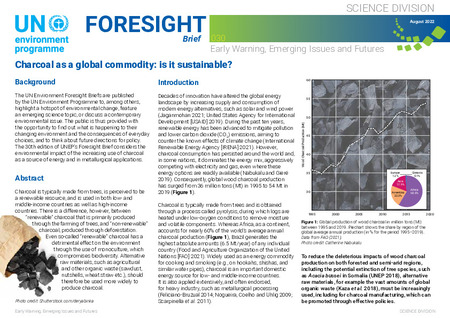| dc.contributor | Science Division | en_US |
| dc.contributor.author | United Nations Environment Programme | en_US |
| dc.contributor.other | Gieré, Reto | en_US |
| dc.contributor.other | Nabukalu, Catherine | en_US |
| dc.contributor.other | Branch, Adam | en_US |
| dc.contributor.other | Mabele, Mathew Bukhi | en_US |
| dc.coverage.spatial | Global | en_US |
| dc.date.accessioned | 2022-08-11T09:41:44Z | |
| dc.date.available | 2022-08-11T09:41:44Z | |
| dc.date.issued | 2022-08 | |
| dc.identifier.uri | https://wedocs.unep.org/20.500.11822/40469 | |
| dc.description | Charcoal is typically made from trees, and is perceived to be a renewable resource, and is used in both low and middle-income countries as well as high-income countries. There is a difference, however, between “renewable” charcoal that is primarily produced through the farming of trees, and “non-renewable” charcoal, produced through deforestation. Even so-called “renewable” charcoal has a detrimental effect on the environment through the use of monoculture, which compromises biodiversity. Alternative raw materials, such as agricultural and other organic waste (sawdust, nutshells, wheat straw etc.), should therefore be used more widely to produce charcoal. | en_US |
| dc.format | Text | en_US |
| dc.language | English | en_US |
| dc.language | French | |
| dc.rights | Public | en_US |
| dc.subject | CHARCOAL | en_US |
| dc.subject | ORGANIC WASTE | en_US |
| dc.subject | SAWDUST | en_US |
| dc.subject | NUTSHELLS | en_US |
| dc.subject | WHEAT STRAW | en_US |
| dc.title | Charcoal as a Global Commodity: Is it Sustainable? - Foresight Brief No. 030 August 2022 | en_US |
| dc.title.alternative | Le charbon de bois, en tant que produit de base mondial, est-il durable ? | |
| wd.identifier.sdg | SDG 7 - Affordable and Clean Energy | en_US |
| wd.identifier.sdg | SDG 11 - Sustainable Cities and Communities | en_US |
| wd.identifier.sdg | SDG 12 - Responsible Consumption and Production | en_US |
| wd.identifier.pagesnumber | 9 pages | en_US |



